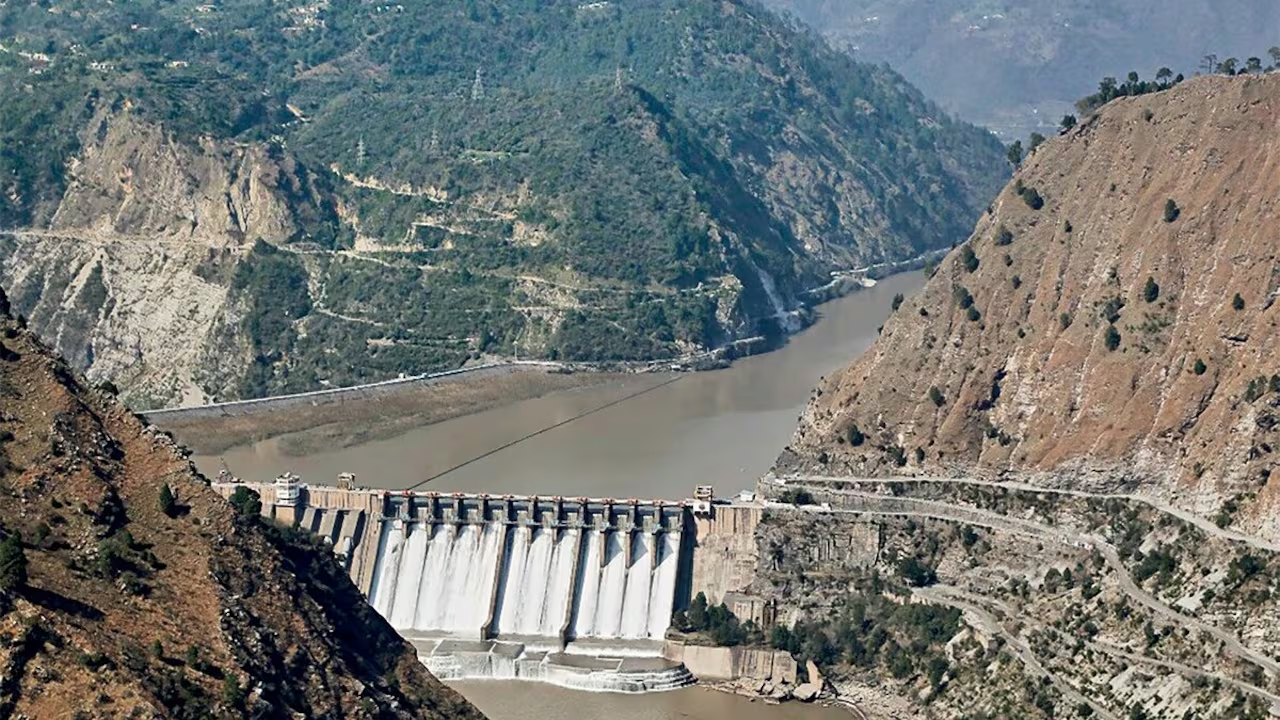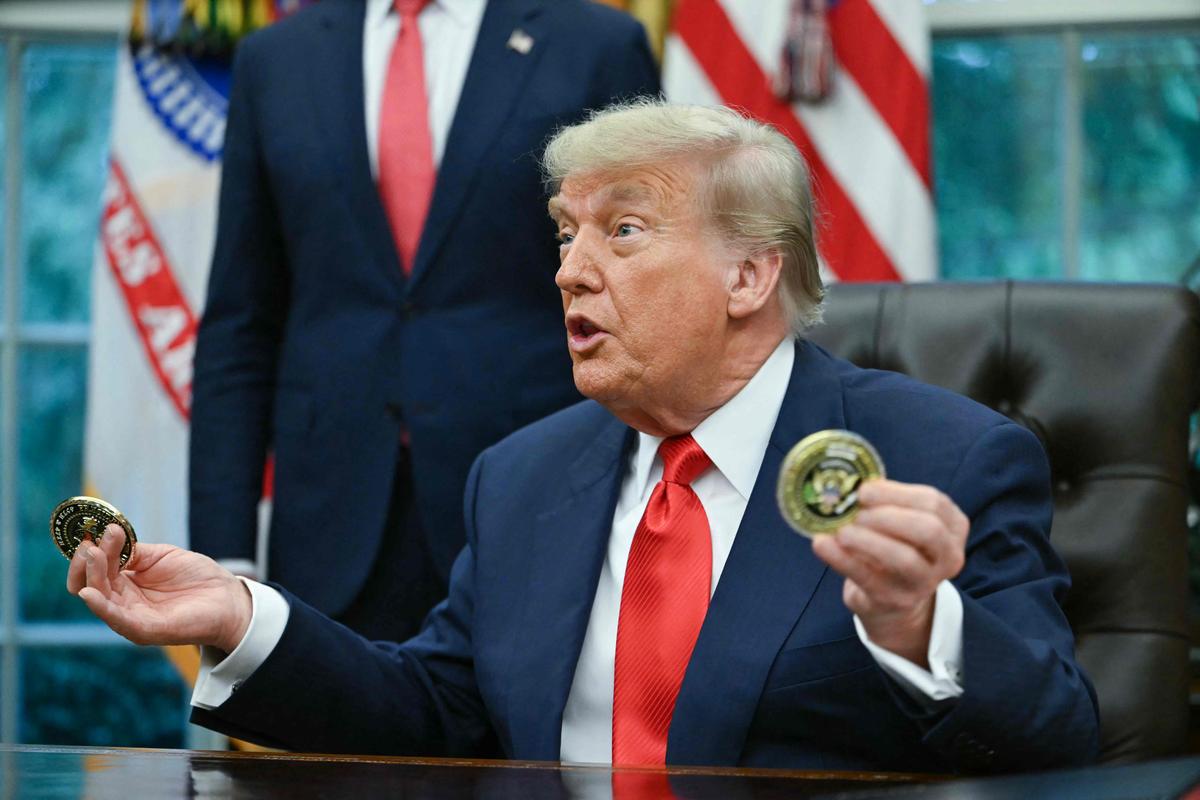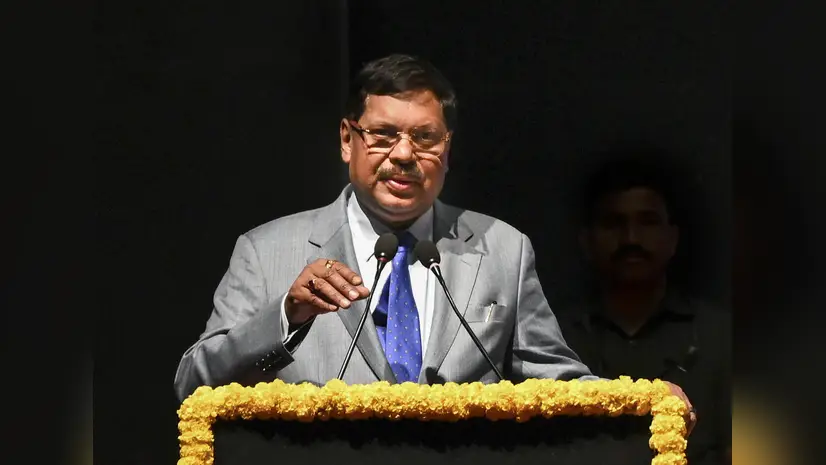- Courses
- GS Full Course 1 Year
- GS Full Course 2 Year
- GS Full Course 3 Year
- GS Full Course Till Selection
- Answer Alpha: Mains 2025 Mentorship
- MEP (Mains Enrichment Programme) Data, Facts
- Essay Target – 150+ Marks
- Online Program
- GS Recorded Course
- Polity
- Geography
- Economy
- Ancient, Medieval and Art & Culture AMAC
- Modern India, Post Independence & World History
- Environment
- Governance
- Science & Technology
- International Relations and Internal Security
- Disaster Management
- Ethics
- NCERT Current Affairs
- Indian Society and Social Issue
- NCERT- Science and Technology
- NCERT - Geography
- NCERT - Ancient History
- NCERT- World History
- NCERT Modern History
- CSAT
- 5 LAYERED ARJUNA Mentorship
- Public Administration Optional
- ABOUT US
- OUR TOPPERS
- TEST SERIES
- FREE STUDY MATERIAL
- VIDEOS
- CONTACT US
RAM TEMPLE: A NEW ERA FOR BHARAT
RAM TEMPLE: A NEW ERA FOR BHARAT
- On 22 January, 2024, a momentous event took place – The consecration of the Ram Mandir.
- As India celebrated 75 years as a Republic and entered into the Amrit kaal. Prime Minister Narendra Modi, with hope, views this as the beginning of a new time period, a 'new kaal chakra.'
- This vision extends beyond the construction of a temple; It's about creating a powerful, skilled, and spiritual India moving towards a grown and wealthy future, included in Modi's idea of 'Developed India'.
- This feeling of revival is not just in India's religious or cultural areas but also seen in its economic successes, like going beyond worldwide stock markets and strong economic forecasts.
- However, the aim is not only economic success but also cultural and moral depth.
- The Ram Mandir is a sign of this new path towards a wealthy and united India, a dream that remembers old knowledge while moving forward to a hopeful future.
Ram Janmabhoomi movement, a significant event in India's recent history
Early History (1751-1856)
- Maratha Requests: In 1751 and 1756, the Marathas, a powerful group in India, asked the Nawab of Awadh to give them control over Ayodhya, Kashi, and Mathura. Their request was related to their military support to the Nawab, but it wasn't successful.
- First Records of Dispute: In 1822, a court case in Faizabad (Ayodhya) first mentioned a dispute about a mosque, believed to be built by Emperor Babur, being on the birthplace of Lord Ram, a major deity in Hinduism.
Mid-19th Century Conflicts (1855-1856)
- Violent Clash in 1855: A major conflict happened between Hindus and Muslims at Hanuman Garhi, near the Babri Masjid (the mosque in question). Many people were killed. This clash led to Hindus gaining control over an area believed to be Ram's birthplace.
- Further Tensions: An attack on Ram Janmabhoomi (the birthplace of Lord Ram) by Amir Ali Amethawi occurred in 1856, but British troops stopped it.
Early Legal Battles (1858-1949)
- First FIR: In 1858, a complaint was filed against Nihang Sikhs for performing Hindu rituals in the Babri Masjid.
- Denied Permission for Temple: In 1885, a Hindu religious leader, Raghubar Das, asked for legal permission to build a Ram temple near Babri Masjid. The court said no, worrying about violence and the long time that had passed since the supposed original temple.
Post-Independence Escalation (1949-1989)
- Temple Proposal in 1949: In 1949, a proposal for a temple at the site was sent to the UP government. The same year, a controversial event occurred where the idol of Lord Ram was allegedly placed inside the mosque, leading to a major dispute.
- Formation of Hindu Mahasabha Resolution: The UP Hindu Mahasabha passed a resolution for the 'liberation' of Ram Janmabhoomi.
- Legal and Political Turmoil: The government's decision to not remove the idol led to significant political and legal consequences, including resignations and elections.
Movement Intensifies (1983-1992)
- Congress Leader's Appeal: In 1983, a Congress leader appealed to the Prime Minister to return Ayodhya, Kashi, and Mathura to Hindus.
- VHP's Announcement: In 1984, the Vishwa Hindu Parishad (VHP) launched a movement for the 'liberation' of these sites.
- Unlocking of Babri Masjid: In 1986, the Babri Masjid was unlocked for Hindu prayers, which intensified the dispute.
- BJP's Involvement: In 1989, the BJP became actively involved, supporting the temple movement. A foundation-laying ceremony was conducted.
Climax and Legal Battles (1990-2019)
- Rath Yatra and Riots: LK Advani's Rath Yatra in 1990 led to widespread riots and deaths.
- Demolition of Babri Masjid: In 1992, the Babri Masjid was demolished, leading to nationwide violence and political fallout.
- Legal Proceedings: In 1993, Parliament passed an act to acquire the disputed land. In 2009, the Liberhan Commission reported that the demolition was planned. In 2010, the Allahabad High Court divided the land, but this was challenged in the Supreme Court.
- Finally, in 2019, the Supreme Court gave the disputed land to Hindus for a Ram temple and provided separate land for a mosque. The temple's foundation was laid by Prime Minister Modi in 2020, with the inauguration planned for January 2022.
Global Perspective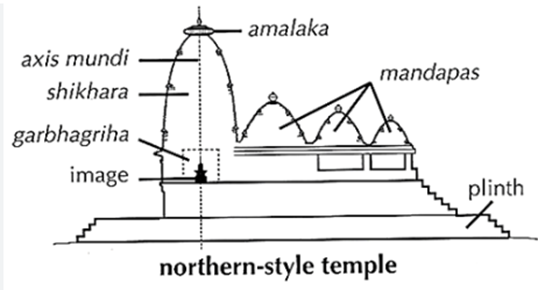
-
International Reactions: The dispute and its resolution have been closely watched globally, reflecting on India's international image as a secular, democratic nation.
Architectural Heritage and Design
-
The Sompura Family: The original design for Ram Mandir was created in 1988 by the Sompura family Chief Architect Chandrakant Sompura from Ahmedabad, known for their expertise in temple architecture. They have a history of designing over 100 temples worldwide, including the famous Somnath temple.
2020 Design Modifications
-
New Design: In 2020, the Sompuras updated the original design. This revised plan adheres to traditional Hindu architectural texts the Vastu Shastra and Shilpa Shastras.
-
Dimensions: The temple, upon completion, will be 76 meters wide, 120 meters long, and 49 meters high, making it the world's third-largest Hindu temple.
-
Architectural Style: It is designed in the Māru-Gurjara architecture style of the Nagara style, prevalent in northern India.
What is the Nagara style of temple architecture?
The basic form of a Hindu temple contains the following architectural elements:
-
Garbhagriha – the small room where the principal deity/deities of the temple reside
-
Mandapa – The entrance hall or covered area at the front of the temple is usually made to hold many people.
-
Shikhara – the mountain like spire which can have different shapes from pyramidal to curvilinear
-
Vahana – the mount of the main deity placed generally in line of sight from Garbhagriha
-
In this style, the temple is generally constructed on an upraised platform called Jagati.
-
Mandapas are located in front of the temple. They are decorated with the Shikhara, the highest one being above the Garbhagriha.
-
The shikhara over the mandapas in the pictures of the Ayodhya Ram temple can be seen having a square base, and a rectilinear outline.
-
This is called the phamsana-style shikhara. Note that the mandapa shikhara right at the entrance has an octagonal base.
To Similar khajuraho Temple
-
There are different types of Shikhara found in Indian temples.
-
A comparison with Khajuraho Vishwanath temple, also built in Nagara style, shows the similarity between the two.
-
Note that the main shikhara of the two are remarkably similar.
-
They rise upward in a curved pyramidal fashion, ending in a horizontal fluted disc called an Amalaka topped with a Kalasha. This is called the Latina-style shikhara.
Features of Shri Ram Janmbhoomi Mandir
-
The Mandir is in the traditional Nagar style.
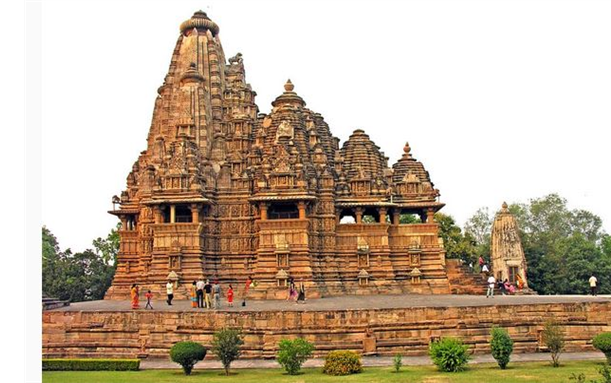
-
The Mandir has a length (east-west) of 380 feet, a width of 250 feet, and a height of 161 feet.
-
The Mandir is three-storied, with each floor being 20 feet tall. It has a total of 392 pillars and 44 doors.
-
In the main sanctum sanctorum, there is the childhood form of Bhagwan Shri Ram (the idol of Shri Ram Lalla) and on the first floor, there will be a Shri Ram Darbar.
-
Five Mandaps (Hall) - Nritya Mandap, Rang Mandap, Sabha Mandap, Prarthna and Kirtan Mandaps.
-
Statues of deities, gods, and goddesses adorn the pillars and walls.
-
Entry is from the east, ascending 32 stairs through the Singh Dwar.
-
Provision of ramps and lifts for the convenience of the differently-abled and elderly.
-
The Parkota( Rectangular compound wall) with a length of 732 meters and a width of 14 feet, surrounds the Mandir.
-
At the four corners of the compound, there are four Mandirs - dedicated to Surya Dev, Devi Bhagwati, Ganesh Bhagwan and Bhagwan Shiv. In the northern arm is a Mandir of Maa Annapurna and in the southern arm is a Mandir of Hanuman ji.
-
Near the Mandir is a historic Well (Sita koop), dating back to the ancient era.
-
In the Shri Ram Janmbhoomi Mandir complex, there are proposed Mandirs dedicated to Maharshi Valmiki, Maharshi Vashishtha, Maharshi Vishwamitra, Maharishi Agastya, Nishad Raj, Mata Shabri, and the revered consort of the Devi Ahilya.
-
In the southwestern part of the complex, at Kuber Tila, the ancient Mandir of Bhagwan Shiv has been restored, along with the installation of Jatayu.
-
No iron is used anywhere in the Mandir.
-
The foundation of the Mandir has been constructed with a 14-meter- thick layer of roller-compacted concrete (RCC), giving it the appearance of artificial rock.
-
For protection against ground moisture, a 21-foot-high plinth has been constructed using granite.
-
The Mandir complex has a sewage treatment plant, water treatment plant, water supply for fire safety and an independent power station.
-
A Pilgrims Facility Centre (PFC) with a capacity of 25,000 people is being constructed, it will provide medical facilities & Locker facility to the pilgrims.
-
The complex will also have a separate block with a bathing area, washrooms, washbasin, open taps, etc.
-
The mandir is being constructed entirely using Bharat’s traditional and indigenous technology. It is being constructed with particular emphasis on environmental-water conservation with 70% of the 70-acre area being left green.
Construction Partners and Techniques
-
Larsen & Toubro's Contribution: This company oversaw the design and construction, serving as the project's contractor.
-
Technical Support: Various institutes like the Central Building Research Institute, National Geophysical Research Institute, and IITs in Bombay, Guwahati, and Madras assisted in areas such as soil testing and concrete supply.
-
Materials Used: The construction used 17,000 m³ of sandstone from Rajasthan. No iron or steel was used; stone blocks were fused using ten thousand copper plates.
Cultural and Global Significance
-
Thailand's Contribution: Reflecting the temple's cultural significance, Thailand sent soil to the Ram Janmabhoomi site, continuing their tradition of honoring the temple, which began with sending water from Thai rivers.
Principal Deity: Ram Lalla
-
Identity of Ram Lalla: Ram Lalla, the child form of Lord Rama, an incarnation of the Hindu god Vishnu, is the central deity of the Ram Mandir.
-
Representation: This form represents Lord Rama as a 5 year-old child, symbolizing innocence and divine childhood.
Cultural and Religious Significance
-
Connection with Devotees: The portrayal of Ram as "Ram Lalla" or the child Rama, holds a deep emotional and spiritual connection with devotees, symbolizing joy and divine simplicity.
-
Ram Lalla's Dress: The deity's dress is traditionally stitched by tailors with a generational history of serving the idol, signifying the continuity of devotion and service.
Temple Structure and Deities
-
Blueprint of Temple: The final plan for the temple includes shrines dedicated to other Hindu deities such as Surya, Ganesha, Shiva, Durga, Vishnu, and Brahma, reflecting the syncretic nature of Hinduism.
-
Idols of Ram Lalla: Two idols of Ram Lalla, including one depicting him at the age of five, are consecrated in the temple's sanctum.
Selection of the Idol
-
Voting Process for Idol Selection: On 29 December 2023, the idol of Ram Lalla for the Ram Mandir was selected through a voting process, emphasizing community involvement in the temple's spiritual matters.
-
Sculptor Arun Yogiraj: The idol was crafted by Arun Yogiraj, a renowned sculptor from Mysore, Karnataka, known for his contributions to various statues across India.
Bhumi Pujan Ceremony
-
Ceremony: Prime Minister Narendra Modi performed the Bhumi Pujan on 5 August 2020, marking the official restart of construction.
-
Vedic Rituals: A three-day Vedic ritual was held, featuring the installation of a 40 kg silver brick as the foundation stone.
-
Invitation of Deities: The Ramarchan Puja was performed to invite all major Hindu deities to the temple site.
Collection of Sacred Materials
-
Soil and Water from Holy Sites: Soil and water were collected from various sacred places across India, symbolizing the unity and sanctity of the nation.
-
Participation of Various Religious Sites: This collection included materials from Hindu temples, gurudwaras, Jain temples, and the Char Dham pilgrimage sites.
Involvement of Political and Religious Leaders
-
Prime Minister's Participation: Narendra Modi's role in the ceremony underscored the project's national significance.
-
Speeches by Dignitaries: Prominent figures like Yogi Adityanath, Mohan Bhagwat, and Nritya Gopal Das spoke at the event, highlighting the temple's cultural and religious importance.
Ram Mandir Construction (2021–Present) : Nationwide Donation Campaign
-
Mass Contact and Contribution Campaign: Launched to reach 55 to 600 million people for voluntary contributions.
-
Donation Range: Donations started from ₹1, symbolizing mass participation regardless of financial status.
-
Prominent Contributions: Former President Ram Nath Kovind made a significant donation, inspiring leaders and citizens across India to contribute.
-
Total Collection: By April 2021, approximately ₹5,000 crore was raised, showing widespread support for the project.
Inclusivity and Community Participation
-
Participation Across Communities: Notably, the donation drive saw contributions from people of different faiths, including Muslims and Christians, highlighting a sense of communal harmony.
-
VHP's Role: Around 150,000 VHP activists were involved in collecting donations, indicating strong organizational support.
Progress and Challenges in Construction
-
Public Viewing Location: A special area was set up for visitors to observe the construction progress.
-
Debris Removal and Foundation Work: Significant groundwork was undertaken, including the removal of debris and the use of roller-compacted concrete for the foundation.
-
Construction Milestones: By mid-September 2021, 47-48 layers of the foundation were completed. However, challenges like electricity supply issues in Mirzapur affected sandstone cutting.
Technological and Cultural Aspects
-
3D Construction Video: In early 2022, a 3D video detailing the temple's construction plan was released, providing a digital glimpse into the project.
-
Use of Ancient Rocks for Idol: In January 2023, two ancient Shaligram rocks from Nepal were brought to carve the idol of Ram Lalla, blending geological history with religious significance.
Completion and Inauguration
-
Construction Milestones: By August 2023, 70% of the groundwork and 40% of the roof work were completed.
-
Final Stages: By December 2023, the base and the six smaller temples surrounding the main temple were nearly finished.
-
Grand Inauguration: The temple and its premises were inaugurated on 22 January 2024, with the Prana Pratishtha ceremony of Ram Lalla. Key figures like Prime Minister Narendra Modi, Yogi Adityanath, Mohan Bhagwat, and Nritya Gopal Das led the ceremony, marking a historic moment in the temple's journey.
Overview of Prana Pratishtha Ceremony
-
Significance: The Prana Pratishtha ceremony is a sacred Hindu ritual marking the consecration of a deity's idol, symbolizing the infusion of life into the idol.
-
Date of Celebration: This momentous event was celebrated on 22 January 2024, marking a significant milestone in the Ram Mandir's journey.
Government Support and Cultural Events
-
Uttar Pradesh Government's Contribution: The state government allocated ₹100 crore for 'Ramotsav', a series of religious and cultural events.
-
Span of Celebrations: These events, involving 826 local bodies, began in December 2023 and reached their zenith around Makar Sankranti on 16 January 2024, continuing until the temple's inauguration.
-
Ram Paduka Yatra: This procession retraced the route of Lord Rama's 14-year exile, connecting the celebrations with mythological significance.
Involvement of National Leaders and Dignitaries
-
Diverse Participation: Prime Minister Narendra Modi, RSS leader Mohan Bhagwat, Congress leaders, and representatives from other political parties were invited, reflecting a wide political spectrum.
-
Guest List: The event attracted a diverse array of guests, including prominent industrialists, scientists, actors, army officers, spiritual leaders, and Padma awardees, showcasing the temple's national importance.
Cultural and Religious Impact
-
Integration of Tradition and Modernity: The event blended traditional Hindu rituals with contemporary celebration styles, illustrating India's cultural diversity.
-
National Unity: The participation of leaders and dignitaries from various fields symbolized the unifying power of the temple beyond religious boundaries.
International Reactions
Pakistan's Official Statement: Pakistan criticized India for starting the temple's construction, referencing the site's contentious history.
Domestic Praise for the Ceremony
Support from Indian Political Leaders: Various political leaders in India praised the ceremony, viewing it as a significant cultural and religious milestone.
Consecration Controversy
Non-participation of Shankaracharyas: The four highest gurus of Advaita Vedanta did not participate in the inauguration ceremony.
Cultural Representation
Republic Day Parade and Durga Puja Celebrations: Uttar Pradesh's tableau at the 2021 Republic Day parade and a Durga Puja celebration in Kolkata featured replicas of the Ram Mandir, indicating its cultural impact.
Slogans and Their Impact
-
"Mandir Wahi Banayenge" Slogan: This slogan, meaning "The temple will be built exactly there," has been a popular and symbolic phrase in the Ram Janmabhoomi movement since the mid-1980s.
-
Cultural Penetration: The slogan has permeated various aspects of Indian culture, including politics, media, comedy, and social festivities.
-
Variations and Adaptations: Different versions of the slogan have been used, each emphasizing the commitment to building the temple at the disputed site.
As we look to the future, the Ram Mandir is more than a religious symbol. It represents the unity in India's diverse culture. It's a place where history, faith, and new hopes come together. This shows a picture of India that respects its past and is ready for its future. The building and opening of the temple is not just about making an old dream come true. It's about starting a new chapter in India's history - a chapter about including everyone, moving forward, and valuing our rich cultural heritage.
In this new time, the Ram Mandir will be more than a place for prayer. It will stand as a symbol of India's changing identity. It mixes old traditions with new ways, showing how the country can bring different things together in a positive and forward-thinking story. The temple is a sign of India's journey, with its struggles, successes, and hopes, showing a nation that is proud of its culture and excited to make progress and live in harmony.

